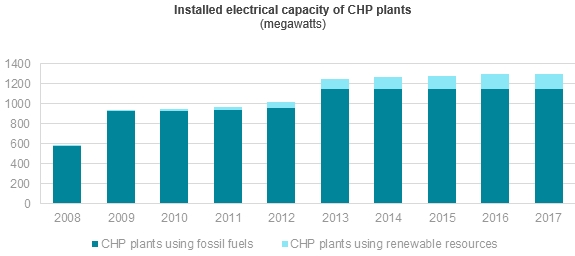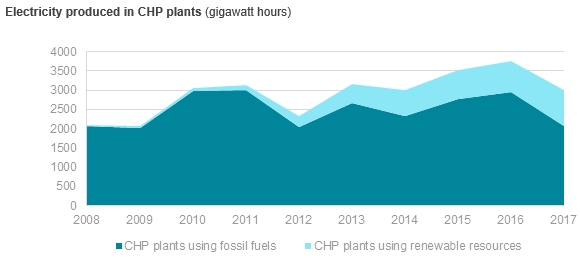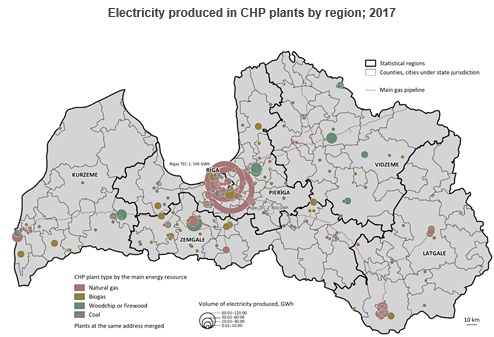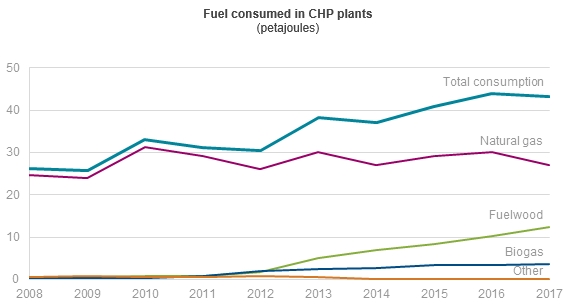Analytics, Energy, Good for Business, Latvia
International Internet Magazine. Baltic States news & analytics
Friday, 26.04.2024, 03:31
Rise in electricity produced in CHP plants from renewable energy sources in Latvia
 Print version
Print versionIndicators
characterizing activities of CHP plants in 2017
|
Installed electrical capacity of CHP plants |
Number of
CHP plants |
Total installed electrical capacity, MW |
Electricity
produced, GWh |
Heat
produced, GWh |
|
|
|
|||||
|
Total |
204 |
1 299.1 |
3 000.1 |
6 301.7 |
|
|
≤ 0.2 MW |
28 |
4.1 |
22.2 |
48.2 |
|
|
0.2 < P* ≤ 0.5 MW |
39 |
14.8 |
77.8 |
255.8 |
|
|
0.5 < P ≤ 1 MW |
71 |
58.3 |
368.8 |
750.0 |
|
|
1 < P ≤ 5 MW |
59 |
144.2 |
861.3 |
2 016.7 |
|
|
5 < P ≤ 20 MW |
3 |
27.9 |
102.8 |
156.3 |
|
|
> 20 MW |
4 |
1 049.8 |
1 567.2 |
3 074.7 |
|
*P – electrical capacity
Last year, there were 204 active CHP plants in Latvia, which is six CHP plants more than in 2016. Since 2008, the total installed electric capacity of CHP plants has increased 2.2 times reaching 1299.1 MW in 2017, which is 1% or 7 MW more than in 2016.

In Latvia, there are four CHP plants with installed electrical capacity exceeding 20 MW, and it takes 81% of the total installed electrical capacity in all CHP plants. The amount of electricity produced in these plants accounted for 52% of the total amount of electricity produced in CHP plants. Three of the plants are located in Riga and one in Zemgale region.
In 2017, the CHP plants in Riga had the highest installed electrical capacity – 1 059.9 MW, which almost has not changed since 2013. The CHP plants in Zemgale region had the second highest installed electrical capacity (70.0 MW) that grew by 10% or 6.2 MW over the year. In its turn, the lowest installed electrical capacity was recorded in CHP plants located in Kurzeme region (32.5 MW) and it has risen by 11%. Compared to 2016, the installed electrical capacity in Pierīga region rose by 7% and reached 58.0 MW, while in Vidzeme and Latgale regions it fell by 9% and 4%, respectively.

Since 2008, the installed electrical capacity of CHP plants powered by RES has grown 15 times. Compared to 2016, the installed electrical capacity of these CHP plants has gone up by 8%, reaching 155 MW in 2017.
Since 2008, the share of electricity produced in RES-fuelled CHP plants has grown by 29 percentage points, and last year 930 GWh of electricity were produced from RES, constituting 31% of the total amount of electricity produced in CHP plants. Rise in the amount of electricity produced in RES-fuelled CHP plants is facilitated by the State aid.

In 2017, the largest share of electricity produced from RES in CHP plants was registered in Vidzeme and Zemgale regions – 89% and 82%, respectively, while the smallest share was observed in Riga – 3% of the total electricity produced in the region.
In 2017, Latvian CHP plants mainly consumed natural gas (27.1 petajoules (PJ)) and fuelwood (12.4 PJ). During the period from 2008 to 2017, the share of natural gas consumed in CHP plants fell from 94% to almost 63%, while the share of RES consumed grew by 33 percentage points, reaching 37% in 2017.

Latvia aims2 at reaching 40% of RES in the gross final consumption of energy by 2020 thus reducing Latvian energy dependency upon imports of energy resources.
Information on activities of CHP plants will be published on 20 June in the CSB database section Environment and Energy.
Methodological explanations
1Cogeneration (combined heat and power production) – simultaneous generation of electricity and heat in the same technological device and cycle using natural gas, biogas, solid fuels, liquid fuels and fuelwood.
2 Regulations of the Cabinet No 129 “On Energy Development Guidelines for 2016–2020”.








 «The Baltic Course» Is Sold and Stays in Business!
«The Baltic Course» Is Sold and Stays in Business!

